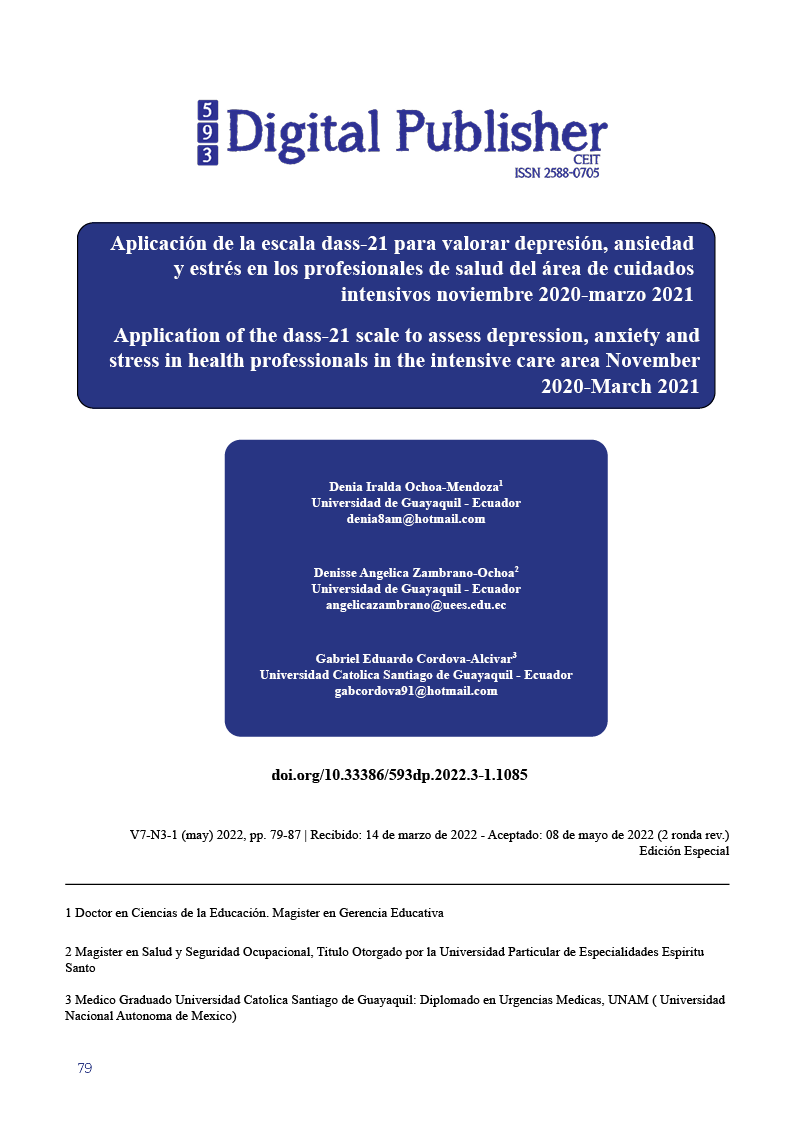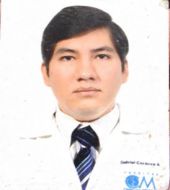Application of the dass-21 scale to assess depression, anxiety and stress in health professionals in the intensive care area November 2020-March 2021
Main Article Content
Abstract
In the fight against the Covid-19 (COVID-19) epidemic, health personnel reported episodes of depression, anxiety and stress, today the severity at an emotional level can be evaluated through the DASS-21 scale and thus know the occupational health as it is handled in the area of these personnel. Objective to identify the presence of anxiety, stress and depression in health professionals in the intensive care area. Methodology descriptive, cross-sectional study carried out in a population of 60 health workers, sociodemographic variables and risk factors to know the state Psychopathological, the DASS-21 scale and section A2 of the ENEMDU questionnaire were used to identify occupational hazards. Results The results indicate that 60% of the study population suffers from psychopathological problems, and this was predominant in the female sex with 58.3%. Statistical difference was evidenced between knowledge of occupational hazards between medical personnel with 50% and personnel of nursing assistants with 8.3%. Conclusions: The DASS-21 scale is a tool that should not be lacking when making an occupational record to prevent mental health risks in health workers.
Downloads
Article Details

This work is licensed under a Creative Commons Attribution-NonCommercial-ShareAlike 4.0 International License.
1. Derechos de autor
Las obras que se publican en 593 Digital Publisher CEIT están sujetas a los siguientes términos:
1.1. 593 Digital Publisher CEIT, conserva los derechos patrimoniales (copyright) de las obras publicadas, favorece y permite la reutilización de las mismas bajo la licencia Licencia Creative Commons 4.0 de Reconocimiento-NoComercial-CompartirIgual 4.0, por lo cual se pueden copiar, usar, difundir, transmitir y exponer públicamente, siempre que:
1.1.a. Se cite la autoría y fuente original de su publicación (revista, editorial, URL).
1.1.b. No se usen para fines comerciales u onerosos.
1.1.c. Se mencione la existencia y especificaciones de esta licencia de uso.
References
Asamblea Constituyente. (2008). Constitución de la República del Ecuador. Recuperado el 2 de Marzo de 2020, de http://www.trabajo.gob.ec/wp-content/uploads/downloads/2012/08/Constitucion-20081.pdf
Benach, J., Julià, M., Tarafa, G., Mir, J., Molinero, E., & Vives, A. (2015). La precariedad laboral medida de forma multidimensional: distribución social y asociación con la salud en Catalu˜na. Gaceta Sanitaria, 375-378.
Brooks, K., & Thomas, A. (Octubre de 2018). Barriers to WHS Adoption in Australian Fisheries FRDC 2017-046. Recuperado el 10 de Marzo de 2020, de Workplace Health & Safety Survey Findings: file:///D:/Users/RRHH/Downloads/2017-046-Appendix%204_WHS%20Survey%20Findings%20(1).pdf
Benavides, F. G., Merino Salazar, P., Cornelio, C., Avila Assunção, A., Agudelo Suárez, A. A., Amable, M., . . . Vives, A. (10 de Octubre de 2016). Cuestionario básico y criterios metodológicos para las Encuestas sobre Condiciones de Trabajo, Empleo y Salud en América Latina y el Caribe. Cadernos de Saúde Pública [online], 32(9). Recuperado el 4 de Marzo de 2020, de https://doi.org/10.1590/0102-311x00210715
Barrios Casas, S., & Paravic Klijn, T. (2006). Promoción de la salud y un entorno laboral saludable. Revista Latino-Americana de Enfermagem, 14(1), 136–141. Https://doi.org/10.1590/s0104-11692006000100019
CODIGO DEL TRABAJO. (26 de Septiembre de 2012). CODIGO DEL TRABAJO. Recuperado el 10 de Marzo de 2020, de http://www.trabajo.gob.ec/wp-content/uploads/downloads/2012/11/C%C3%b3digo-de-Tabajo-PDF.pdf
CNA. (2020). CAMARA NACIONAL DE ACUACULTURA. Recuperado el 26 de 02 de 2020, de ESTADÍSTICAS - CAMARA NACIONAL DE ACUACULTURA: http://www.cna-ecuador.com/estadisticas/
De Cuyper, N., De Jong, J., De Witte, H., Isaksson, K., Rigotti, T., & Schalk, R. (2008). Literature review of theory and research on the psychological impact of temporary employment: Towards a conceptual model. International Journal of Management Reviews, 25-51.
Del Brutto, O., Mera, R., Del Brutto, V., Maestre, G., Gardener, H., & Zambrano, M. (2014). Influence of depression, anxiety and stress on cognitive performance in community-dwelling older adults living in rural Ecuador: Results of the Atahualpa Project. Geriatr Gerontol .
Escalona, E. (2006). Relación salud-trabajo y desarrollo social: visión particular en los trabajadores de la educación. Rev Cubana Salud Pública, 1-19.
EKOS. (25 de Marzo de 2019). Zoom al sector camaronero. Recuperado el 15 de Enero de 2020, de https://www.ekosnegocios.com/articulo/zoom-al-sector-camaronero
FAO. (2018). ORGANIZACION DE LAS NACIONES UNIDAS PARA LA ALIMENTACION Y LA AGRICULTURA.
Fao-onu. (1995). Codigo de conducta para la pesca responsable. Roma, italia: n/s n/c..
Fundación Clínica Médica Sur, México. (2021, abril). Mental health risks and damage in healthcare personnel due to treating patients with COVID-19 (N.o 3). MEDIGRAPHIC. https://www.medigraphic.com/pdfs/uro/ur-2020/ur203i.pdf
Gómez, A. (2017). I Encuesta sobre Seguridad y Salud en el Trabajo para Ecuador: I-ESST. Cienciamérica, 6(2), 67-75. Recuperado el 1 de Marzo de 2020, de http://www.cienciamerica.us/openjournal/index.php/uti/issue/archive
Guia sobre el estrés ocupacional. (2006). Obtenido de http://portal.ugt.org/: http://portal.ugt.org/saludlaboral/observatorio/publicaciones/cuader_guias/2006 _guia_estres_laboral.pdf
Hernández, r., fernández, c., & baptista, m. D. (2010). Metodología de la investigación. México df: mc graw-hill/ interamericana editores.
Iess. ( 2001). Ley de seguridad social. Recuperado el 2 de marzo de 2020, de ley de seguridad social, registro oficial suplemento 465: http://www.trabajo.gob.ec/wp-content/uploads/downloads/2012/11/ley-de-seguridad-social.pdf.
INEC. (2017). GESTIÓN DE ESTADÍSTICAS PERMANENTES A HOGARES. Ecuador en Cifras. https://www.ecuadorencifras.gob.ec/documentos/web-inec/EMPLEO/2017/Junio/FORMULARIO%20ENEMDU%20RONDA%20LVI%20-%20JUNIO%20-2017%20web.pdf
Instituto ecuatoriano de seguridad social. (s.f.). Decreto ejecutivo 2393 reglamento de seguridad y salud de los trabajadores y mejoramiento del medio ambiente de trabajo. Recuperado el 10 de marzo de 2020, de seguro general de riesgos del trabajo: https://www.prosigma.com.ec/pdf/nlegal/decreto-ejecutivo2393.pdf
Martínez-Lanz, P., Medina-Mora, M. E., & Rivera, E. (2004). Adicciones, depresión y estrés en médicos residentes. Revista de la facultad de medicina UNAM.
Mascarúa-Lara, E., Vazquez-Cruz, E., & Códova-Soriano, J. (2014). Ansiedad y depresión en médicos residentes de la especialidad en Medicina Familia. Atención Familiar
Ngajilo, D., & Jeebhay, M. F. (30 de Mayo de 2019). Lesiones y enfermedades profesionales en acuicultura: una revisión de la literatura. (Elsevier, Ed.) Acuicultura, 507, 40-55.
OMS. (20 de Febrero de 2020). Https://www.who.int/es. Obtenido de https://www.who.int/es/about/who-we-are/frequently-asked-questions
OMS. (30 de Noviembre de 2017). Protección de la salud de los trabajadores. Recuperado el 29 de Febrero de 2020, de https://www.who.int/es/news-room/fact-sheets/detail/protecting-workers’-health
OIT. (2019). Seguridad y Salud en el centro del futuro del trabajo: Aprovechar 100 años de experiencia (Primera ed.). Ginebra, Suiza: Organización Internacional del Trabajo. Recuperado el 3 de Marzo de 2020, de https://www.ilo.org/wcmsp5/groups/public/---dgreports/---dcomm/documents/publication/wcms_686762.pdf
OIT. (2020). Promover el empleo y el trabajo decente en un panorama cambiante. Resumen ejecutivo, Conferencia Internacional del Trabajo. Recuperado el 4 de Marzo de 2020, de https://www.ilo.org/wcmsp5/groups/public/---ed_norm/---normes/documents/publication/wcms_736658.pdf
Raquel Sánchez. (2018). La salud autopercibida, fenómeno multidimensional de gran interés en el campo de la investigación en salud. Ciencias de la Salud, 1-3. Obtenido de https://www.universidadviu.com/la-salud-autopercibida-fenomeno-multidimensional-gran-interes-campo-la-investigacion-salud/
Talavera-Velasco, B., Luceño-Moreno, L., Martín-García, J., & Díaz-Ramiro, E. M. (2017). Asociación entre la percepción de condiciones laborales adversas y depresión: una revisión sistemática. Ansiedad y Estrés, 23(1), 45–51. https://doi.org/10.1016/j.anyes.2017.05.002
Vera Carrasco, O. (2016). EL CONSENTIMIENTO INFORMADO DEL PACIENTE EN LA ACTIVIDAD ASISTENCIAL MÉDICA. Medica La paz, 59-68.
Wang. (30 de 03 de 2020). Obtenido de doi:https://doi.org/10.1016/S0140-6736(20)30185.
Zabala A., V., Dominic, B., & Calvopiña, A. (Marzo de 2019). Zoom al Sector Camaronero. Ekos, 108 - 116.




